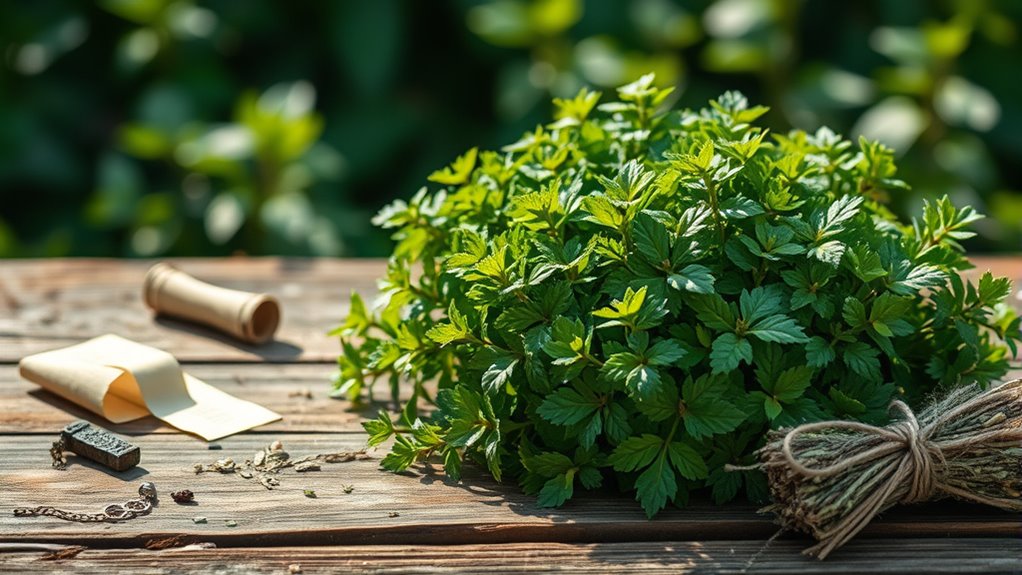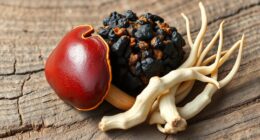Mugwort’s magical uses span many cultures, where you’ll find it valued for protection, spiritual insight, and healing. In European traditions, it’s burned to ward off evil, enhance dreams, and promote spiritual awakening. Asian practices use it for detoxification, calming nerves, and connecting with ancestors. Ancient Europeans saw it as a bridge between worlds, while Chinese medicine employs it to support health and spirituality. If you continue, you’ll discover how these rich traditions can inspire your own spiritual journey.
Key Takeaways
- Mugwort is used in European folk traditions for protection, enhancing dreams, and spiritual awakening through burning or wearing as amulets.
- In Asian practices, mugwort promotes healing, detoxifies, and is used in rituals to ward off evil spirits and negative energies.
- Ancient European mythology associates mugwort with safeguarding travelers, warding off evil, and connecting with divine or spiritual realms.
- Traditional Chinese Medicine employs mugwort to improve circulation, support women’s health, and in shamanic rituals for purification.
- Modern spirituality utilizes mugwort in protective charms, dream enhancement, and space cleansing through burning or placing under pillows.
European Witchcraft and Folk Traditions

European witchcraft and folk traditions have long regarded mugwort as a powerful herb with protective and magical properties. You might use mugwort in your medicinal applications to promote vivid dreams, ward off evil spirits, or ease digestive issues. Its ritual symbolism is deeply rooted in European practices, where it’s often burned to purify a space or worn as an amulet for protection. Mugwort’s association with the night and dreams made it a popular ingredient in charms and spells designed to enhance clairvoyance. Its significance extends to its role in seasonal celebrations and rituals, symbolizing purification, foresight, and spiritual awakening. Additionally, the use of unique and wicked planters for growing mugwort can enhance its spiritual ambiance during rituals. Incorporating traditional herbal magic practices can deepen your connection to the herb’s mystical qualities. Understanding how mugwort’s medicinal properties have been utilized historically helps explain its enduring reputation in European folk magic. By understanding these traditional uses, you see how mugwort’s mystical reputation has persisted through centuries of European folk magic.
Asian Herbal Practices and Spiritual Rituals

In Asian herbal practices and spiritual rituals, mugwort continues to hold a revered place for its protective and healing qualities. You’ll find it valued for its medicinal properties, which include boosting circulation, calming nerves, and clearing toxins. Its use extends beyond healing; mugwort also embodies strong ritual symbolism. Practitioners incorporate it in cleansing ceremonies to ward off evil spirits and negative energies. During festivals and spiritual rituals, you might burn mugwort or use it in amulets to enhance spiritual protection. Its scent is believed to purify spaces and invite positive energy. Understanding its cultural significance helps illuminate the deep spiritual connections many cultures have with this mystical herb. The practice of ritual symbolism underscores its importance in various cultural traditions. Its enduring role highlights its importance across diverse herbal and ritual practices, often linked to traditional healing practices that emphasize holistic well-being. Additionally, the use of mugwort in spiritual symbolism reflects its significance as a conduit for connecting with higher energies and ancestral spirits. Its association with dream induction further emphasizes its role in facilitating spiritual journeys and heightened awareness during rituals.
Mugwort in Ancient European Mythology

Mugwort’s presence in ancient European mythology underscores its significance as a powerful symbol of protection, magic, and spiritual insight. The plant was revered for its medicinal properties, believed to ward off evil spirits and enhance clairvoyance. In myth, mugwort often represented a bridge between the physical and spiritual worlds, making it a key element in rituals and rites of passage. Its ritual symbolism extended to protection during travel and sleep, as people believed it could guard against nightmares and malevolent forces. Cultures such as the Celts and Germans associated mugwort with divine power, using it in sacred ceremonies to invoke spiritual guidance. Its role in Personal Finance Management and other cultural practices illustrates its enduring significance as a mystical plant rooted deeply in European mythological traditions. Historically, mugwort’s use in medieval herbal practices further emphasizes its valued status across different eras and societies. Additionally, the plant’s widespread use in herbal medicine highlights its importance in both spiritual and healing contexts throughout history. The plant was also believed to possess protective qualities, making it a common component in charms and amulets designed to safeguard individuals from harm. Furthermore, mugwort was often incorporated into various rituals and charms, reinforcing its reputation as a protective and mystical herb.
Uses in Traditional Chinese Medicine and Shamanic Practices

Across cultures, mugwort has long been valued for its medicinal and spiritual properties, extending beyond European traditions into Asian practices. In Traditional Chinese Medicine, you may use mugwort to stimulate circulation, improve digestion, and support women’s health, especially during menstruation. Its aromatic qualities also contribute to aromatherapy benefits, helping to relax and clear the mind. Shamanic practices incorporate mugwort in rituals for purification and protection, often burning it as an incense to cleanse spaces or invoke spiritual guidance. Additionally, mugwort finds culinary applications in Chinese cuisine, where its leaves are used to add flavor and medicinal qualities to soups and teas. Herbal preparations and techniques for using mugwort are integral to these diverse practices, allowing practitioners to harness its full potential. By integrating mugwort into these practices, you tap into a plant with deep cultural roots and versatile uses that transcend mere tradition.
Modern Spirituality and Protective Magic

Modern spirituality often embraces mugwort as a powerful tool for protection and energetic cleansing. You can use it to enhance dreamwork, helping you access deeper insights or ward off negative energies during sleep. Placing mugwort in your sleeping area or under your pillow can improve dream clarity and promote protective energy. Many people incorporate mugwort into protective amulets or charms, believing it creates a barrier against harmful influences. Burning mugwort as incense is another popular practice, releasing its purifying smoke to clear your space of unwanted energies. By integrating mugwort into these routines, you strengthen your energetic boundaries and foster a sense of safety. Understanding the role of sound design in crafting immersive sensory experiences can also deepen your connection to protective rituals. Its versatile use in modern protective magic makes it a valuable addition to your spiritual toolkit. Additionally, exploring herbal traditions across cultures can provide further insights into its protective properties and enhance your practice. Incorporating educational tools like guided visualizations or affirmations can further amplify the protective effects of mugwort in your spiritual routines. Recognizing the importance of spiritual energy helps you better understand how mugwort interacts with your energetic system to provide protection.
Frequently Asked Questions
Can Mugwort Be Safely Used in Culinary Recipes?
Yes, you can safely use mugwort in culinary recipes, but with caution. It’s important to take into account culinary safety, as excessive consumption can cause adverse effects. Mugwort adds a unique, slightly bitter flavor that enhances dishes, especially in teas or stuffed foods. Use it sparingly, and verify it’s properly prepared to avoid any potential risks. Always consult reliable sources or experts before incorporating mugwort into your cooking regularly.
Are There Any Health Risks Associated With Mugwort Consumption?
Picture mugwort as a double-edged sword in your garden; while it offers benefits, it also poses risks. You should be aware of allergic reactions, which can be severe, and toxicity concerns if consumed in large amounts. Always start with small doses, especially if you’re sensitive, and consult a healthcare professional. Ignoring these risks could lead to unwanted health issues, so proceed cautiously with mugwort consumption.
How Is Mugwort Traditionally Prepared for Spiritual Rituals?
You typically prepare mugwort for spiritual rituals by making herbal infusions or using it in smoke cleansing. To create an infusion, steep dried mugwort leaves in boiling water, then drink or use the liquid in rituals. For smoke cleansing, burn dried mugwort until it smolders, then waft the smoke around your space or yourself to purify and invite positive energy. These methods help harness mugwort’s traditional spiritual powers.
Does Mugwort Have Any Proven Medicinal Properties Today?
Like a whisper of nature’s secrets, mugwort’s medicinal efficacy remains uncertain. Scientific research has yet to conclusively prove its health benefits, so you should approach it with caution. While traditional uses suggest potential, modern studies haven’t confirmed significant medicinal properties. Trust in evidence-based medicine, but feel free to explore mugwort’s historical significance—just remember, its true power isn’t fully validated by science yet.
What Are the Ecological Impacts of Harvesting Mugwort Wild?
Wild harvesting mugwort can disrupt ecological balance, especially if done unsustainably. You might unintentionally harm local plant populations, reduce biodiversity, and disturb habitats for wildlife. Overharvesting can lead to soil erosion and diminish the plant’s ability to regenerate. To protect the environment, it’s better to harvest responsibly, consider cultivated sources, and avoid overharvesting areas where mugwort naturally thrives. This way, you help maintain ecological balance while enjoying its benefits.
Conclusion
As you explore mugwort’s rich history, you realize its power stretches across cultures and centuries. Its secrets have been guarded, its magic woven into rituals both ancient and modern. But what other mysteries lie hidden within its leaves? With each new tradition, you sense there’s more to uncover—powers waiting to be unleashed. Will you dare to delve deeper, discovering the true extent of mugwort’s mystical potential? The journey into its secrets has only just begun.










